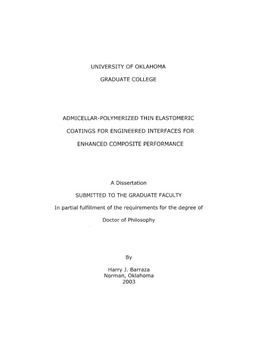| dc.contributor.advisor | O'Rear, Edgar A., | en_US |
| dc.contributor.author | Barraza, Harry J. | en_US |
| dc.date.accessioned | 2013-08-16T12:19:03Z | |
| dc.date.available | 2013-08-16T12:19:03Z | |
| dc.date.issued | 2003 | en_US |
| dc.identifier.uri | https://hdl.handle.net/11244/635 | |
| dc.description.abstract | A surface-polymerization technique known as admicellar polymerization has been evaluated as an alternative method to tailor the interfacial properties of glass/epoxy composite parts molded by resin transfer molding (RTM). Initially, small-scale polymerization reactions were carried out to investigate the feasibility of covering glass fibers with a thin elastomeric film that would render them fairly hydrophobic. After the treatment, the admicellar-modified fibers not only exhibited a chemically heterogeneous surface with high contact angles with water (thetaa = 72 +/- 8); but also had statistically identical wetting characteristics to fibers coated with commercial sizings when probed with an epoxy resin (Epon 815C). In subsequent experiments, random-mat glass fibers modified with the same technique described above were used as the reinforcement for RTM-parts molded in a high-speed setup. These disk-shaped parts were mechanically tested, both under dry and wet conditions, to study the enhancement in structural integrity achieved with the insertion of controlled-thickness elastomeric interphases. It is worth noting that RTM composites containing woven fabrics coated with poly (styrene-co-isoprene), at different coverage levels, gave a similar dry-adhesion performance trend as the random-mat reinforcement. Firstly, tensile properties augmented in more than 50% for all cases; whereas, the interlaminar shear strength (ILSS) increased proportionally with the amount of elastomeric film present. For this particular admicellar sizing the ILSS level was only 9% lower than that observed with a silane-based commercial sizing, which signals the potential of admicellar sizings as alternative coatings for glass fiber reinforcements with comparatively similar performance as the proprietary organosilane treatments. | en_US |
| dc.description.abstract | Wet-adhesion properties of random-mat glass fibers with admicellar sizings were investigated by transient water sorption measurements carried out at constant temperature (45° C). Admicellar polystyrene and poly (styrene-co-isoprene) coatings appear to create an interface with much higher resistance to moisture attack than the organosilane/matrix interface in composites with commercial sizing. In all, the results described herein have implications for composite manufacture applications because they show the possibility of creating tailored interfaces from pure polymers with relatively low market prices. (Abstract shortened by UMI.) | en_US |
| dc.format.extent | xv, 275 leaves : | en_US |
| dc.subject | Engineering, Materials Science. | en_US |
| dc.subject | Polymerization. | en_US |
| dc.subject | Fibrous composites. | en_US |
| dc.subject | Engineering, Chemical. | en_US |
| dc.subject | Elastomers. | en_US |
| dc.subject | Textile Technology. | en_US |
| dc.title | Admicellar-polymerized thin elastomeric coatings for engineered interfaces for enhanced composite performance. | en_US |
| dc.type | Thesis | en_US |
| dc.thesis.degree | Ph.D. | en_US |
| dc.thesis.degreeDiscipline | School of Chemical, Biological and Materials Engineering | en_US |
| dc.note | Adviser: Edgar A. O'Rear. | en_US |
| dc.note | Source: Dissertation Abstracts International, Volume: 64-08, Section: B, page: 3933. | en_US |
| ou.identifier | (UMI)AAI3102431 | en_US |
| ou.group | College of Engineering::School of Chemical, Biological and Materials Engineering | |
